Gillian Larson's
Backcountry & Camping Gear
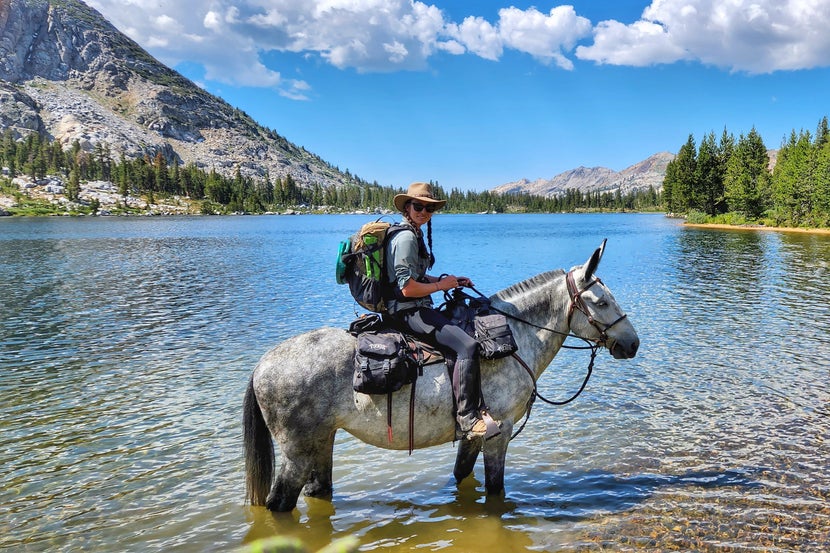
It is hard to imagine anyone having more experience camping in the backcountry with horses than RW-sponsored rider Gillian Larson. She and her equine partners have traveled thousands of miles on long-distance journeys, riding from the Mexican border to the Canadian border: three times on the Pacific Crest Trail, in 2014, 2016, and 2022, and once on the Continental Divide Trail in 2018. Alongside these incredible feats, she has also taken trips on the Arizona Trail, the Colorado Trail, the John Muir Trail, from the Grand Canyon across Utah to Wyoming, and other wilderness routes.
Want to know more about Gillian's background? Meet Thru-Rider Gillian Larson here! Over the years, she has found certain gear that she relies on to make these expeditions more comfortable for her and her horses. Some items are not horse-related, so she follows the lead of hikers with ultra-lightweight backpacking tents, sleeping bags, and cooking equipment. However, she does have a few equine go-to products that make all the difference when she is out on the trail overnight!
Gillian's Backcountry Camping Tips
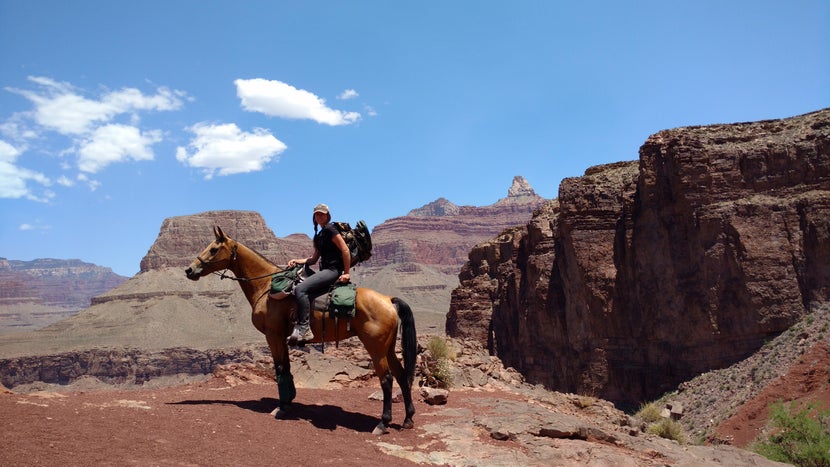
Think Lightweight
Especially if you are trying to carry everything on a single riding horse, it is essential to minimize your load—not just in terms of weight but also bulk. Choose highly compressible, lightweight materials (such as down) for your jacket and sleeping bag; I actually use a sleeping quilt, which I find just as warm as a sleeping bag and less constricting. The only cooking utensil I bring is a Jetboil to make hot water for dehydrated meals. Minimize wherever possible!
Plan Your Route
Do plenty of research before you head out into the backcountry overnight. Be sure you select stock-approved trails and get a backcountry permit if required. Check to see if there are any grazing restrictions, or whether you will have to carry feed; you usually need certified, weed-free hay at trailheads and processed or pelleted feed for the trail. Use topographic maps to identify potential campsites if dispersed camping is allowed. You want to camp where there is a water source and sufficient open space for stock.
Use Communication and Navigation Tools
Having a satellite text device, such as a Garmin InReach, can make all the difference if you or your horse becomes sick or injured. You want to have a way to notify emergency responders of any issues, or to at least stay in contact with someone else who can. Although I always carry a paper map as backup (in case my electronics become disabled), using GPS navigation with a smartphone app, like Gaia or another dedicated trail app, helps me know where I am at all times.
Practice "Leave No Trace"
Being in the backcountry is a privilege, and those of us with stock need to be aware of minimizing our impact by protecting natural resources. The Back Country Horsemen of America (BCHA) organization has a readily available guide for best practices with stock, designed to help preserve the environment and ensure that equestrians will continue to enjoy access to wilderness areas.
Backcountry Must-Haves: For the Horse
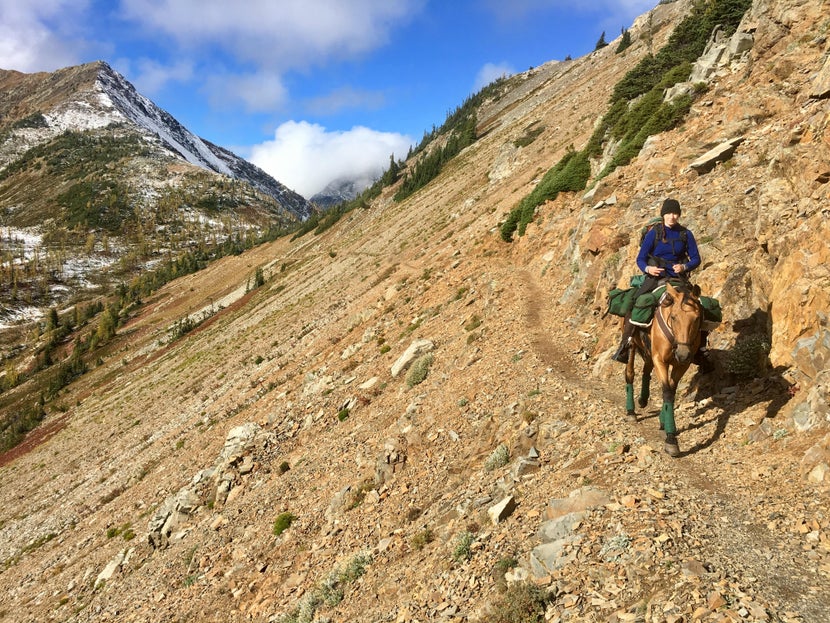
Saddlebags
Having the right set of saddlebags to carry your gear is absolutely necessary for a successful overnight trip with your horse. I love the Tucker Adventurer saddlebags because of their unique design features, including secure attachments to stabilize the bags on your saddle. Numerous individual pockets—large, small, and in-between—help keep your stuff organized and accessible. The set includes both front and rear bags, as well as a detachable cantle bag, which is usually where I tie my raincoat and folding saw. It is great to have a place for everything and be able to find it when you need it!
| Shop the Tucker Adventurer Saddle Bag Full Set |
Stock Containment: Highline
Another crucial element for backcountry camping is a secure form of containment for your horse and any other equine companions. One traditional way to do this is with a highline strung between two trees, which allows you to safely tie your horse without damaging root structures. This method gives your horse some freedom of movement. A good highline kit will include mandatory tree-saver straps to protect the tree bark, a rope, and swivels to slide onto the rope that you tie your horse to. This kit by Tough 1 contains everything needed, as well as a convenient bag to store it all in. If you're looking for some of my tips and tricks on how to highline, look no further! Check out this handy article on How to Set Up a Horse High Line System.
| Shop the Tough 1 2 Horse No-Knot Picket Line Kit |
Stock Containment: Portable Electric Fence
The downside of a highline is that it doesn't allow for grazing and is useless without trees. Having a portable electric fence kit solves both of those problems. However, these kits can be relatively heavy and take up a lot of space; they are more practical if you are traveling with a pack animal and have a greater carrying capacity. I have managed to take mine with a single riding horse by paring down the components and getting creative with attachments to trees and other natural supports for the hotwire. The all-inclusive kit from Max Flex is one of the best options available if you are looking for a lightweight version to take into the backcountry.
Saddle Pad
All of the gear required for overnight camping adds a significant amount of weight that your horse has to carry. Making sure your horse remains comfortable might require a saddle pad different from the one you are regularly using. Supracor pads offer superior weight-distributing support, as well as improved ventilation to help protect against pressure points and heat buildup. Plus, they are super lightweight and easy to clean!
| Shop the Supracor Cool Grip Endurance Saddle Pad- Long Black |
Hoof Protection
Backcountry trails can be tough on your horse's feet, especially in high altitudes above treeline, where there is often nothing but rock underhoof. I usually put my horses in borium-coated shoes for extended-wear life if I will be out for a long-distance ride, but I also always bring along a set of hoof boots as a "spare tire" backup option (in case of a lost shoe). If your horse is usually barefoot or wears boots, you might want to try these super-adjustable, durable, non-rubbing hoof boots by Explora!
| Shop the Explora Magic Hoof Boots Pair (Set of 2) |
Vitamin E Supplement
There are many important elements of nutrition that support your horse's performance in the backcountry, but providing sufficient vitamin E is one that I consider essential. Vitamin E maintains healthy nerve and muscle function and contributes to a strong immune system. Unlike some nutrients, it cannot be synthesized by the horse and must be consumed in the diet, which can lead to a deficiency. Horses lacking in vitamin E are more susceptible to tying up, among other potentially serious conditions. I always make sure my hard-working equine partners are provided with a high-quality supplement, like the vitamin E powder by Kentucky Performance.
| Shop the Kentucky Performance Elevate Powder Natural Vitamin E |
Backcountry Must-Haves: For the Rider
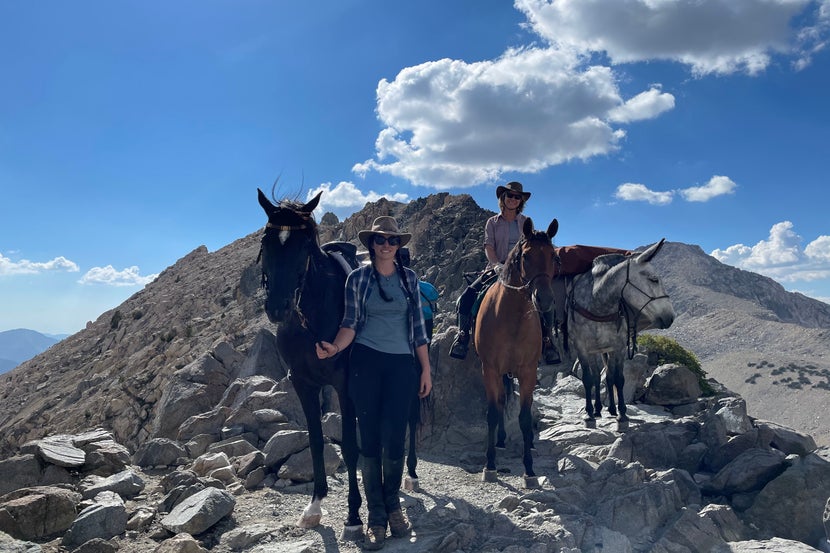
Riding Tights
Long days in the saddle—as well as stretches on foot to give my horse's back a break—make choosing the right riding pants crucial for my own personal comfort. I like riding tights for their stretch and breathability, and the Synergy tights by Irideon are among my favorites. I love the way the side rib panels add compression and muscle support, while the well-designed seams and fabric avoid chafing no matter how many miles I am putting in during the day. In hot weather or desert locations, I am particularly a fan of the Kerrits IceFil tights, a lightweight option with superior cooling technology and added UV protection. The silicone, full-seat pattern provides the right amount of "stick" alongside fabric that offers stretch and moisture-wicking capabilities. Both sets of tights can handle the most rugged wilderness treks!
| Shop the Irideon Women's Synergy Knee Patch Riding Tights Shop the Kerrits IceFil Tech Full Seat Anti-Slip Tights |
Half Chaps
To go with the tights, I usually wear half chaps with a rugged hiking-type boot rather than riding boots. Again, because I spend a lot of time on my feet, I need the additional padding, support, and traction that hiking boots provide. Without half chaps, my lower legs would take a beating! Half chaps protect me against rubs from tree branches or thick brush, and they help keep me drier when I am riding through rain-soaked vegetation. Half chaps act like a gaiter to keep any dirt and debris out of my boots whether I am riding or walking.
| Shop the Ariat Breeze Half Chaps Black |
Face Protection
To top it all off (literally), I always wear some kind of hat to protect my face against both the sun and rain. A classic Stetson feels right for the vagaries of backcountry weather. These hats will have you riding into the sunset without a care in the world!
| Shop Stetson Cowboy Hats |
Closing Thoughts
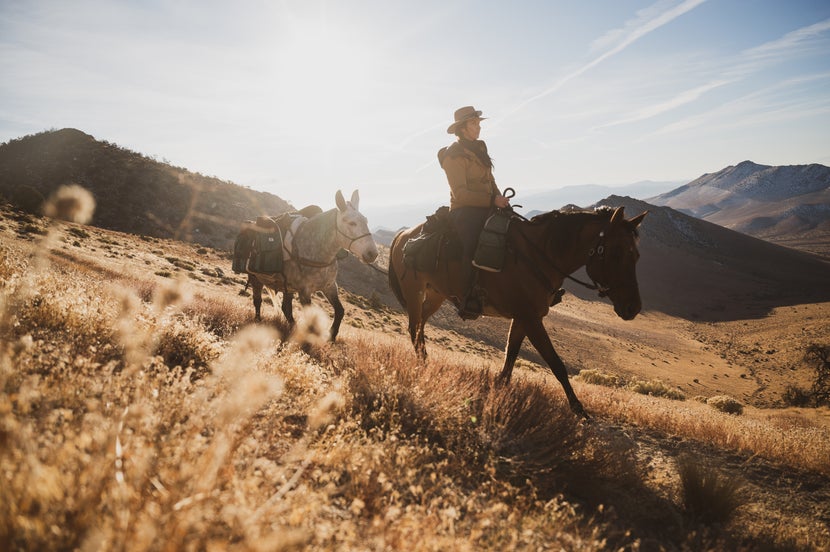
Backcountry riding and camping is not for the faint of heart, but it is one of the most rewarding journeys you can experience with your equine! There's a lot of blood, sweat, and tears poured into both the preparation and execution of a backcountry expedition. We hope Gillian's personal take on this type of riding has taught you something new, or given you a great product recommendation—straight from the horse's mouth! We invite you to shop Gillian's backcountry choices below, and please feel free to call our friendly customer service staff at 1-800-620-9145 or email us at info@ridingwarehouse.com if you have any questions. Happy thru-riding!

